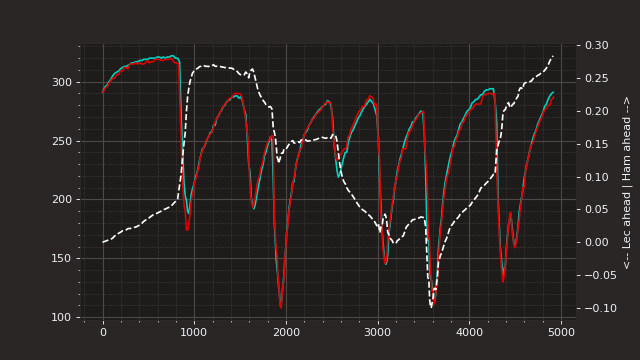Utils module - fastf1.utils¶
This is a collection of various functions.
- fastf1.utils.delta_time(reference_lap, compare_lap)[source]¶
Calculates the delta time of a given lap, along the ‘Distance’ axis of the reference lap.
Deprecated since version 3.0.0.
Warning
This function should no longer be considered as a stable part of the API. Due to the reasons given below, this function will be modified or removed at a future point.
Warning
This is a nice gimmick but not actually very accurate which is an inherent problem from the way this is calculated currently (There may not be a better way though). In comparison with the sector times and the differences that can be calculated from these, there are notable differences! You should always verify the result against sector time differences or find a different way for verification.
Here is an example that compares the quickest laps of Leclerc and Hamilton from Bahrain 2021 Qualifying:
import fastf1 as ff1 from fastf1 import plotting from fastf1 import utils from matplotlib import pyplot as plt plotting.setup_mpl(color_scheme='fastf1') session = ff1.get_session(2021, 'Emilia Romagna', 'Q') session.load() lec = session.laps.pick_drivers('LEC').pick_fastest() ham = session.laps.pick_drivers('HAM').pick_fastest() delta_time, ref_tel, compare_tel = utils.delta_time(ham, lec) # ham is reference, lec is compared fig, ax = plt.subplots() # use telemetry returned by .delta_time for best accuracy, # this ensures the same applied interpolation and resampling ax.plot(ref_tel['Distance'], ref_tel['Speed'], color=plotting.get_team_color(ham['Team'], session)) ax.plot(compare_tel['Distance'], compare_tel['Speed'], color=plotting.get_team_color(lec['Team'], session)) twin = ax.twinx() twin.plot(ref_tel['Distance'], delta_time, '--', color='white') twin.set_ylabel("<-- Lec ahead | Ham ahead -->") plt.show()

- Parameters:
- Return type:
- Returns:
A tuple containing
pd.Series of type float64 with the delta in seconds.
Telemetryfor the reference lapTelemetryfor the comparison lap
Use the return telemetry for plotting to make sure you have telemetry data that was created with the same interpolation and resampling options!
- fastf1.utils.recursive_dict_get(d, *keys, default_none=False)[source]¶
Recursive dict get. Can take an arbitrary number of keys and returns an empty dict if any key does not exist. https://stackoverflow.com/a/28225747
- fastf1.utils.to_timedelta(x)[source]¶
Fast timedelta object creation from a time string
Permissible string formats:
For example: 13:24:46.320215 with:
optional hours and minutes
optional microseconds and milliseconds with arbitrary precision (1 to 6 digits)
Examples of valid formats:
24.3564 (seconds + milli/microseconds)
36:54 (minutes + seconds)
8:45:46 (hours, minutes, seconds)
- Parameters:
x (
Union[str,timedelta]) – timestamp- Return type:
Optional[timedelta]
- fastf1.utils.to_datetime(x)[source]¶
Fast datetime object creation from a date string.
Permissible string formats:
For example ‘2020-12-13T13:27:15.320000Z’ with:
optional milliseconds and microseconds with arbitrary precision (1 to 6 digits)
with optional trailing letter ‘Z’
Examples of valid formats:
2020-12-13T13:27:15.320000
2020-12-13T13:27:15.32Z
2020-12-13T13:27:15
- Parameters:
x (
Union[str,datetime]) – timestamp- Return type:
Optional[datetime]